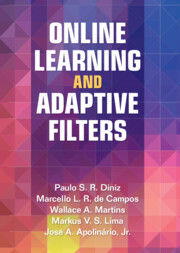4 - Distributed Adaptive Filters
Published online by Cambridge University Press: 24 November 2022
Summary
The chapter shows how the classical adaptive filtering algorithms can be adapted to distributed learning. In distributed learning, there is a set of adaptive filtering placed at nodes utilizing a local input and desired signals. These distributed networks of sensor nodes are located at distinct positions, which might improve the reliability and robustness of the parameter estimation in comparison to stand-alone adaptive filters. In distributed adaptive networks, parameter estimation might be obtained in a centralized form or a decentralized form. The centralized case processes the signals from all nodes of the network in a single fusion center, whereas in the decentralized case, processing is performed locally followed by a proper combination of partial estimates to result in a consensus parameter estimate. The main drawbacks of the centralized configuration are its data communication and computational costs, particularly in networks with a large number of nodes. On the other hand, the decentralized estimators require fewer data to feed the estimators and improve on robustness. The provides a discussion on equilibrium and consensus using arguments drawn from the pari-mutuel betting system. The expert opinion pool is the concept to induce improved estimation and data modeling, utilizing De-Groot’s algorithm and Markov chains as tools to probate equilibrium at consensus. It also introduces the distributed versions of the LMS and RLS adaptive filtering algorithms with emphasis on the decentralized parameter estimation case. This chapter also addresses how data broadcasting can be confined to a subset of nodes so that the overall network reduces the power consumption and bandwidth usage. Then, the chapter discusses a strategy to incorporate a data selection based on the SM adaptive filtering.
Information
- Type
- Chapter
- Information
- Online Learning and Adaptive Filters , pp. 109 - 151Publisher: Cambridge University PressPrint publication year: 2022
